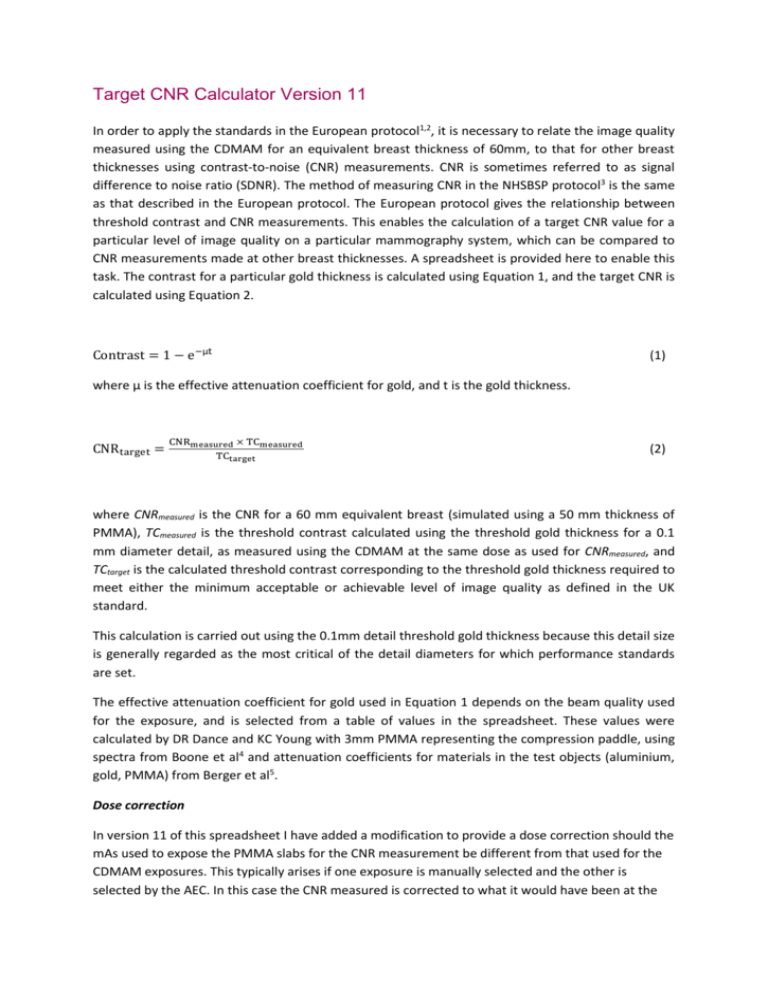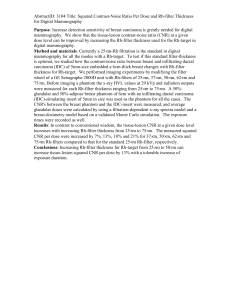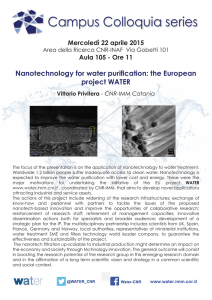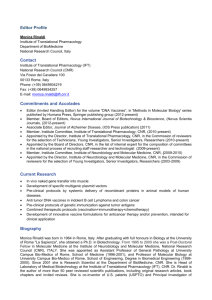here
advertisement

Target CNR Calculator Version 11 In order to apply the standards in the European protocol1,2, it is necessary to relate the image quality measured using the CDMAM for an equivalent breast thickness of 60mm, to that for other breast thicknesses using contrast-to-noise (CNR) measurements. CNR is sometimes referred to as signal difference to noise ratio (SDNR). The method of measuring CNR in the NHSBSP protocol3 is the same as that described in the European protocol. The European protocol gives the relationship between threshold contrast and CNR measurements. This enables the calculation of a target CNR value for a particular level of image quality on a particular mammography system, which can be compared to CNR measurements made at other breast thicknesses. A spreadsheet is provided here to enable this task. The contrast for a particular gold thickness is calculated using Equation 1, and the target CNR is calculated using Equation 2. Contrast = 1 − e−μt (1) where µ is the effective attenuation coefficient for gold, and t is the gold thickness. CNR target = CNRmeasured × TCmeasured TCtarget (2) where CNRmeasured is the CNR for a 60 mm equivalent breast (simulated using a 50 mm thickness of PMMA), TCmeasured is the threshold contrast calculated using the threshold gold thickness for a 0.1 mm diameter detail, as measured using the CDMAM at the same dose as used for CNRmeasured, and TCtarget is the calculated threshold contrast corresponding to the threshold gold thickness required to meet either the minimum acceptable or achievable level of image quality as defined in the UK standard. This calculation is carried out using the 0.1mm detail threshold gold thickness because this detail size is generally regarded as the most critical of the detail diameters for which performance standards are set. The effective attenuation coefficient for gold used in Equation 1 depends on the beam quality used for the exposure, and is selected from a table of values in the spreadsheet. These values were calculated by DR Dance and KC Young with 3mm PMMA representing the compression paddle, using spectra from Boone et al4 and attenuation coefficients for materials in the test objects (aluminium, gold, PMMA) from Berger et al5. Dose correction In version 11 of this spreadsheet I have added a modification to provide a dose correction should the mAs used to expose the PMMA slabs for the CNR measurement be different from that used for the CDMAM exposures. This typically arises if one exposure is manually selected and the other is selected by the AEC. In this case the CNR measured is corrected to what it would have been at the exposure used for the CDMAM using equation 3. This assumes that the CNR is proportional to the square root of the dose and this will be approximately true where quantum noise dominates and for moderate dose differences. Thus equation 2 now becomes equation 4. 0.5 mAs CNR corrected = CNR measured x ( mAsCDMAM ) PMMA CNR target = CNRcorrected × TCmeasured TCtarget (3) (4) Prepared by Ken Young at NCCPM on 1st July 2015. REFERENCES 1. Van Engen R, Young KC, Bosmans H, et al. The European protocol for the quality control of the physical and technical aspects of mammography screening. In: European Guidelines for Quality Assurance in Breast Cancer Screening and Diagnosis, 4th Edition, Luxembourg: European Commission, 2006. 2. van Engen R, Bosmans H, Dance D et al. Digital mammography update: European protocol for the quality control of the physical and technical aspects of mammography screening. In: European guidelines for quality assurance in breast cancer screening and diagnosis, Fourth edition – Supplements. Luxembourg: European Commission, 2013. 3. Workman A, Castellano I, Kulama E et al. Commissioning and Routine Testing of Full Field Digital Mammography Systems (NHSBSP Equipment Report 0604). Sheffield: NHS Cancer Screening Programmes, 2006. 4. Boone JM, Fewell TR and Jennings RJ. Molybdenum, rhodium and tungsten anode spectral models using interpolating polynomials with application to mammography Medical Physics, 1997, 24: 1863-1974. 5. Berger MJ, Hubbell JH, Seltzer SM Chang et al. XCOM: Photon Cross Section Database (version 1.3) http://physics.nist.gov/xcom (Gaithersburg, MD, National Institute of Standards and Technology), 2005.






